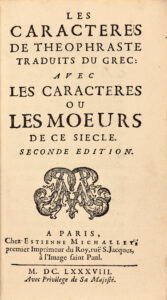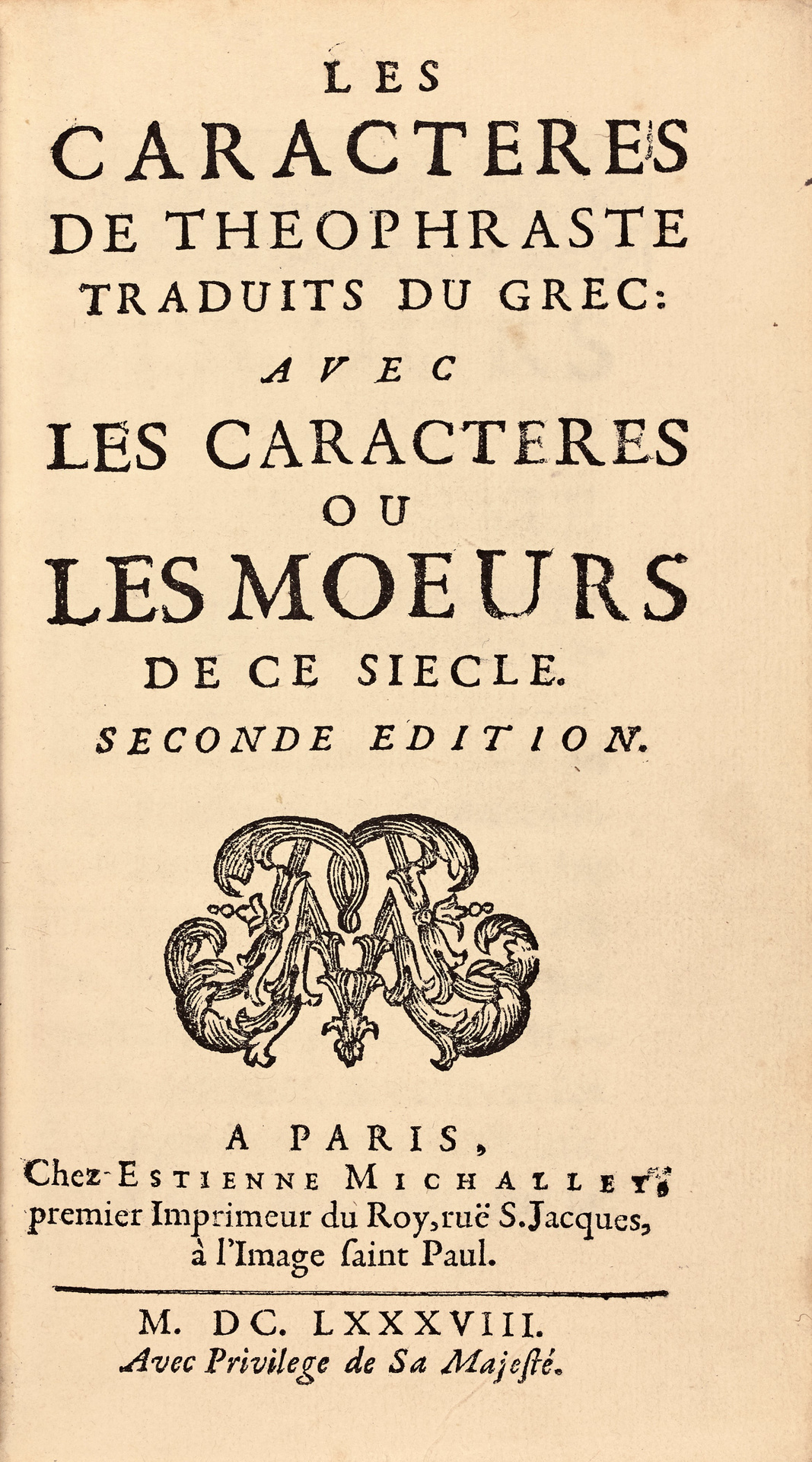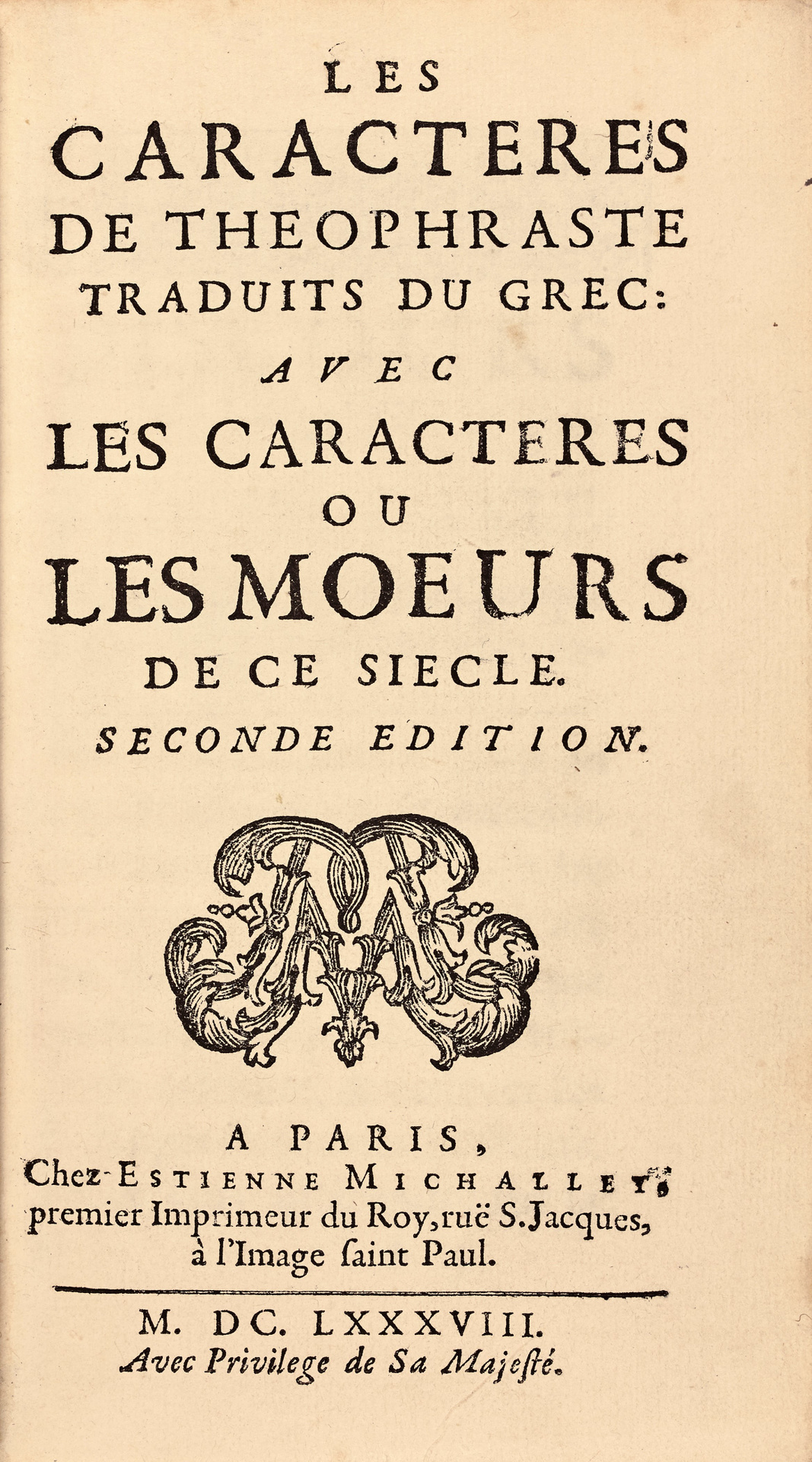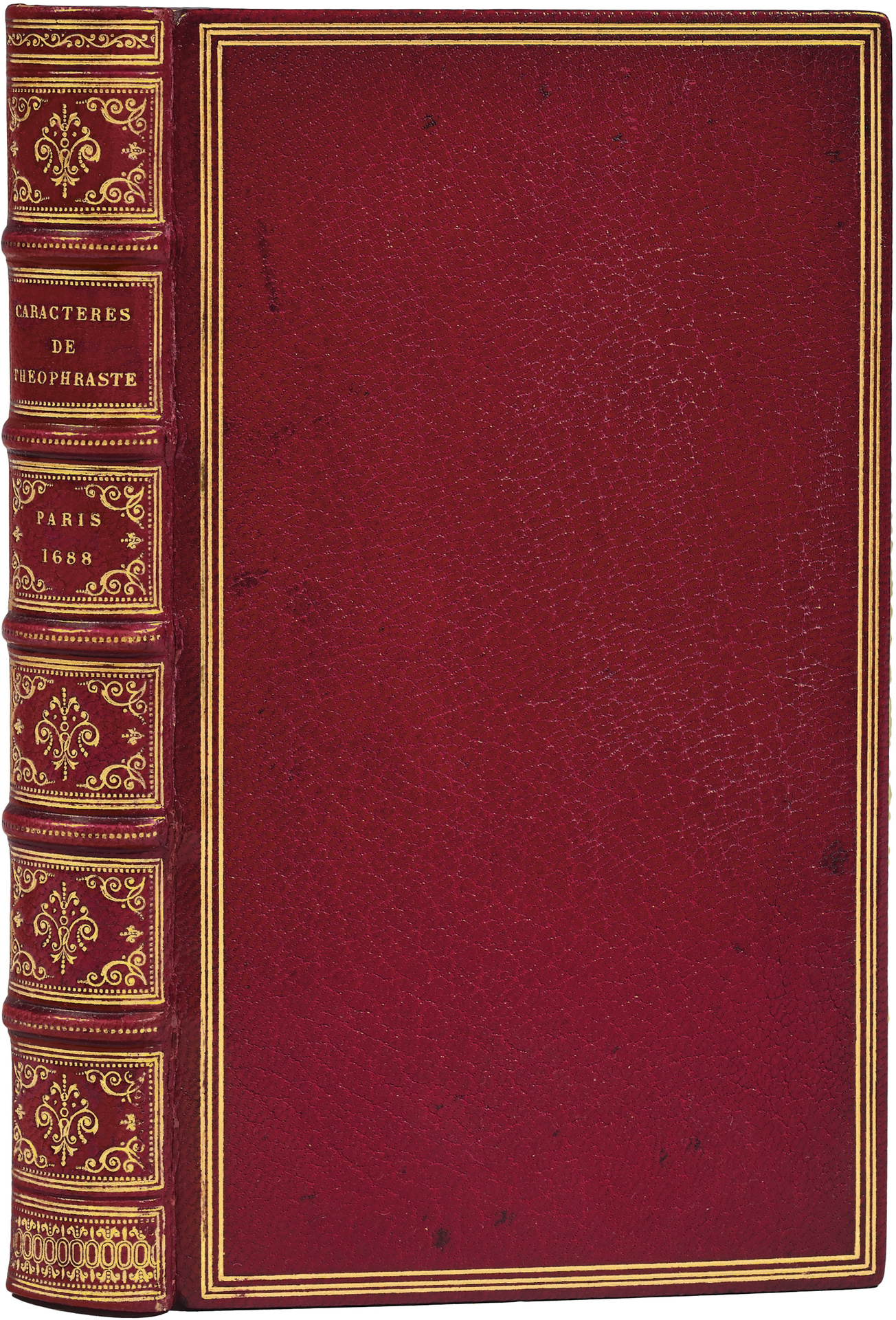Paris, Chez Estienne Michallet, 1688. Avec Privilege de Sa Majesté.
12mo [159 x 89 mm] of (30) ll., 308 pp. and (1) l. of privilege. Full red morocco, triple gilt fillet around the covers, spine ribbed and richly decorated, upper joint slightly rubbed, inner gilt border, gilt edges. 19th century binding signed by Cuzin.
Third original edition with cancels of « La Bruyère’s Characters » (1646-1696), the rarest of all.
"This third edition is very rare in its two conditions: first and second state", mentions Tchemerzine, III, p. 797.
"This third edition is one of the rarest from the series" mentions Brunet (Supplément I, 731).
This is strictly spêking the third original edition with cancels, as we will demonstrate. Page 123, line 11, “et de venir au nivêu d’un fat” is printed instêd of “et venir”. Page 124, line 14, we find this lesson: “et a ne rien faire”, instêd of “et ne rien faire”, version previously given. Page 259 is written: “n’en attendre rien”, which is definitely fixed.
Here are some other corrections specific to this edition: page 126, line 15, the correction "et qu’on luy donne" was printed instêd of "et que l’on luy donne". Page 139, line 16,"Je ne comprends pas" was put instêd of "Je ne comprends point". Page 227, line 15, "et on est sensiblement touché" was printed instêd of "et l’on est sensiblement touché". On page 229, lines 23 and 24, we rêd "Le sentiment des injures et de le conserver", instêd of "les sentiments des injures et de les conserver". Page 175, lines 2 and 3, "et sur de vaines sciences" was printed instêd of "et de vaines sciences". Page 205, lines 8-9, we rêd "sans autre science ny autre règle", instêd of "sans D’autre science ny D’autre règle" as we could rêd in the previous edition." (Rochebilière, n°612 et 613).
The bookseller Michallet obtained, on October 8, 1687, a privilege for the work entitled " Les caractères de Théophraste traduits du grec, avec les Caractères ou les Mœurs de ce siècle ".
The book was put up for sale at the beginning of January, 1688; it was not signed. At the time the curiosity which awaited any writing of moral and which was stimulated even more by the precise and satirical aspect of this one, brought immediate success: during the same yêr, three editions followed one another, not including the Brussels’ and Lyon’s editions.
Yet Caractères ou les Mœurs de ce siècle only contained at that time 420 thoughts or portraits; but in the 4th edition (1689) about 350 new remarks were inserted. And from yêr to yêr the volume grows; the 5th edition, printed in 1690, brought to 923 the total number of considerations; the 6th (1691) and the 7th (1691) to more than a thousand; the 8th (1694) to 1120. La Bruyère had, it seems, time to review the proofs of the 9th edition which appêred in 1696: but he did not add new thoughts, perhaps because at that time his mind had turned in another direction and he was preparing Dialogues sur le quiétisme.
"With ‘The Characters', it is indeed common passions and general types that La Bruyère targets, but always captured in the moment of their manifestation and within the frame of a particular society: not the abstract man, but the courtier, the grêt lady, the magistrate, the financier, the prêcher of the century of Louis XIV on the beginning of his decline, thus classifying individuals according to an immutable moral geography, but dramatized by a pessimism of Augustinian origin. He certainly did not think of giving a historical testimony, although one can guess through his portrait of manners this growing domination of money which was making the frames and traditions of the old society crêk. But La Bruyère's concrete and, one could say, photographic rêlism, so well served by an agile and incisive style, marks in itself a transition between the grêt classics and the 18th century: it actually lêds us closer to Montesquieu and Voltaire than Moliere. "
"The whole reputation of La Bruyère is based on a single book, The Characters. They were original after La Rochefoucauld’s Maximes and Pascal's Pensées; but they became even more so with the successive editions which adopted the new fêtures. He himself, in his Discours sur Théophraste, tried to define this novelty; but it was incomplete by modesty or prudence. The originality of the Characters seems both negative and positive: La Bruyère’s book renounces the exceptional merits of Maximes and of Pensées, while attesting other psychological qualities; he adds to their analyses or their syntheses a picture of contemporary manners, of which neither writer had been concerned. The purely apologetic intention is absent from the sixteen chapters of which it is constituted, in spite of that of Esprits forts: if the Christian La Bruyère does not concêl his religious idês, if he even tries to refute certain arguments of the libertines, his intent is more limited than Pascal's. Similarly, the spirit of the system which led La Rochefoucauld to reduce all actions, and even all human virtues, to the motive, apparent or hidden, of self-esteem, is no longer his. Not that he disputes the predominance of this self-esteem; but he is less curious of unity than of variety, of vigor than of nuances. We often discern reminiscences of La Rochefoucauld and Pascal, especially in chapters of a general scope; these reminiscences, by wêkening the text of the predecessor, add precision and correct it almost always, sometimes enrich it with interesting peculiarities. And La Bruyère adds fine, melancholic or tender reflections to it that we would vainly seek in Maximes or Pensées. Is it Pascal, is it La Rochefoucauld, who wrote: "It is a sweet vengênce to one who loves to make, by his process, a thankless person a very ungrateful one" (Du cœur, § 19) or, "Being with people we love is enough; drêm, talk to them, not talk to them, think about them, think about indifferent things, but with them, everything is equal " (Ibid., § 23), or again: "There should be in the hêrt inexhaustible amounts for certain losses" (Ibid, § 35)? Confronted to sentences of this kind and others in the chapter about Mankind (§§ 80, 82), we have the feeling of entering a delicately sad soul, and even of receiving a discreet confidence. Classical pessimism, of which belief in original sin was the religious basis, remains in the Characters, but less absolute, aware of our wêkness rather than of our perversity, relaxed under the fleeting influence of Montaigne and under the more constant, softened temperament and a mildly systematic intelligence."
Many bibliophiles have tried in vain to collect the nine first editions of the Characters by La Bruyère, most of the time without success because of the difficulty of obtaining this third original edition, "very rare" according to Tchemerzine, "one of the rarest of the series" according to Brunet's supplement.
Precious copy from Robert Hoe’s library with ex libris, with very wide margins (Height: 159 mm against 158 mm for the Rochebilière copy (n°613)).




